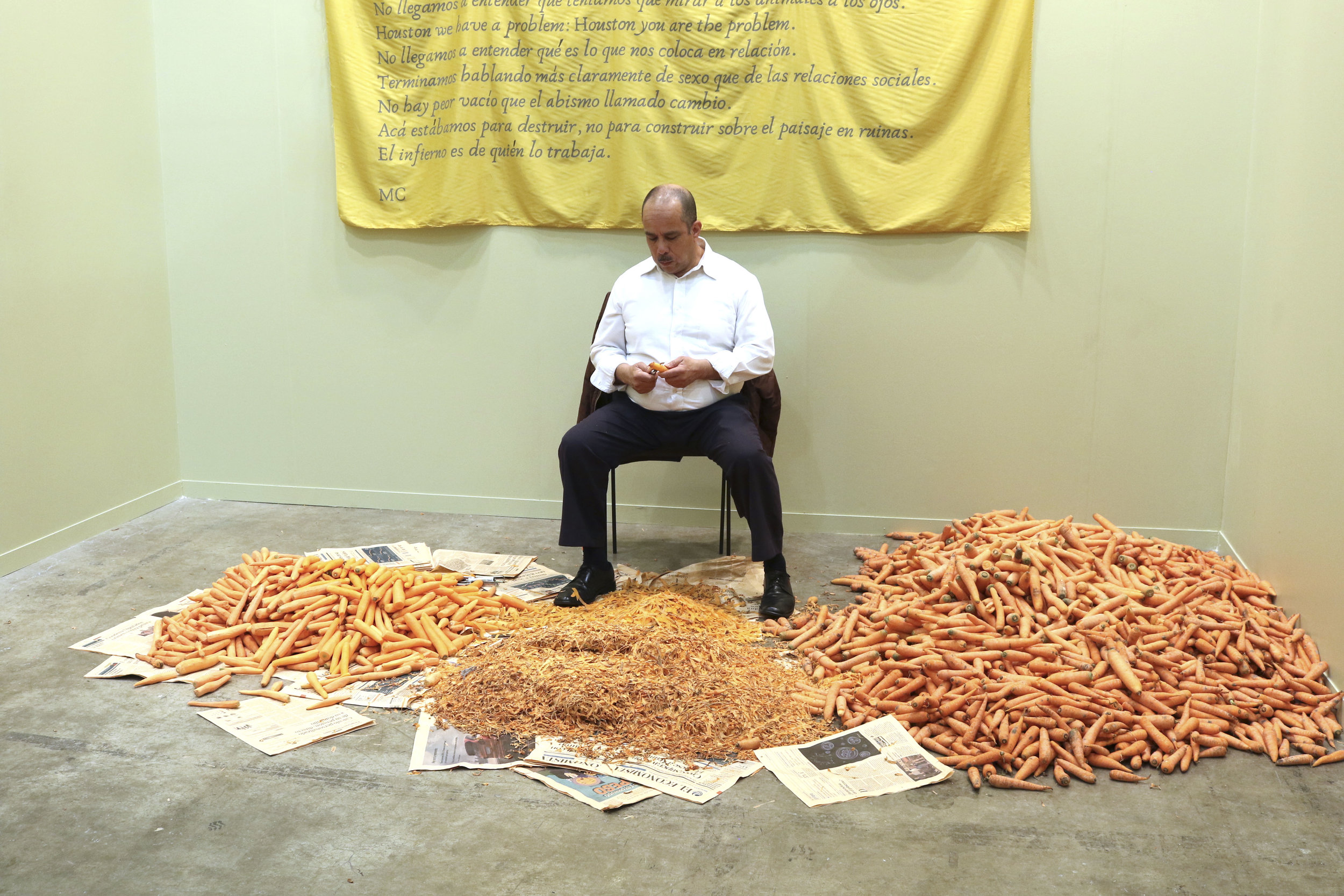Minerva Cuevas | We’d Heard the Carrots Were Fantastic, the Fantasies Carroty
by Guest User
MINERVA CUEVAS. “SEX, WAR, AND BERTOLT BRECHT” (2018). MULTIMEDIA PERFORMANCE. COURTESY OF THE ARTIST, KURIMANZUTTO, AND ZONA MACO. PHOTO: ANDIE EISEN.
Sex, war, and Bertolt Brecht. Minerva Cuevas’ thematic triple-threat, appearing in this year’s Zona Maco art festival, was born in the philosophies of Bertolt Brecht and ended in a pile of peeled carrots. Upon approaching the installation, the viewer is first greeted by a massive orange wall, which bears a written question: “What happens to the hole when the cheese is gone?”
At first glance, the question seems enigmatic and even comical, but it is actually derived from Brecht’s play Mother Courage and Her Children. Although not evident from the quote, Mother Courage is one of nine plays Brecht wrote in resistance to the rise of fascism and Nazism in the late 1930s. The cheese is intended to be a metaphor for war and the holes symbolic of peace, implying that peace can only exist against the background of war. In order to fully understand this elaborate intersection of cheese, carrots, and Marxist playwrights, I head to Cuevas herself.
Originally from Mexico City, Cuevas is petite, forthright, and intensely witty. As we chat in the near-empty VIP seating area of Zona Maco, I struggle to hear her soft voice over the Major Lazer remixes booming over from the collector’s preview. For her Zona Maco installation, Cuevas drew inspiration from Brecht’s wartime novel, Kriegsfibel. “I found the image of the ‘sexy carrot’ in this dense, dark book,” Cuevas explains. This surprising image allowed Cuevas to form a human connection to Brecht and an ability to emotionally relate to his oeuvre. It’s easy to see why, and a mere Google search of the term ‘sexy carrot’ will show you that Cuevas and Brecht are not the only two people who have noticed this delightful phenomenon.
Within the installation stands a glass case with eight bronze castings of comically varied sexy carrots. The crescendo of Cuevas’ installation is a three-day performance in which a middle-aged man in a crisp white shirt individually peels a massive pile of carrots. With this performance, Cuevas gives a nod to Brechtian epic theater. Verfremdungseffekt, the “estrangement effect,” is a device used by Brecht to create a dialectic relationship between the actor and audience.
Brecht hoped that by removing the fictional elements that suspend belief, the spectator would be forced to intellectually participate in the action. In this instance, the man peeling carrots was a paid actor. By monotonously peeling carrots, the actor was engaging in a proletariat action. In another sense, he was continuously ‘undressing’ the carrots, thus contributing to the overarching theme of the ‘sexy carrot.’ “Brecht believed in art for the proletariat,” Cuevas tells me. “I believe it is powerful to have a work inspired by him in such an elite space.”
On the second day of the art fair, the carrot peeler was surrounded by a ring of spectators taking photographs and selfies. Emboldened by verfremdungseffekt, I took a few steps towards the actor and pointed to the pile of peeled carrots. Encouraged by his amusement and a small nod, I picked one up and gave it a dramatic crunch. Many other spectators quickly followed my example, and together we ate through the fourth wall, one sexy Marxist carrot at a time.
Written and Photographed by Andie Eisen


